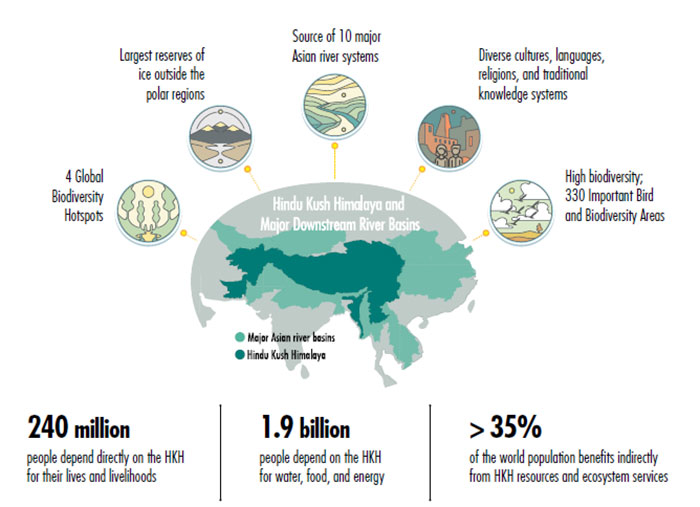Newly appointed ICIMOD DG, (Dr) Pema Gyamtsho writes about why mountains matter on International Mountain Day
Mountains are a barometer of the planet’s health – changes in these lofty parts of the world dictate how rivers flow and crops grow and livelihoods endure elsewhere. And yet, global recognition of these vital regions has been rather underwhelming, in contrast to say the Amazon or the polar regions. International Mountain Day (IMD), celebrated on this very day every year, is a plea to the world to value these mighty, important, neglected regions. We need to recognize that our battle against climate and other changes must be fought at this front – at the highest, most fragile regions of the world where impacts are accentuated – if we are to secure our collective future. And this year’s IMD theme is an apt one – “Mountain biodiversity” epitomizes the uniqueness and importance of mountains. It also brings attention to the multitude of threats that could drastically diminish the diversity of life as we know it, and throws into sharp relief the need to mount a unified effort to protect our mountains.

Immense diversity in the mountains
Mountains are a veritable treasure trove of biodiversity. They cover only around 27 percent of the world’s surface, yet they contribute disproportionately to the terrestrial biodiversity, especially in the tropics, where they host about half of the global biodiversity hotspots. These regions are home to more than 85 percent of the world’s species of amphibians, birds, and mammals, many entirely restricted to mountains. Six of the 20 most important food crops originated in mountains. Studies have found that biodiversity thrives in the mountains despite (or because of) harsh conditions, elevation, and isolation. Moreover, mountain biodiversity shapes communities with unique knowledge and experiences. In fact, there is evidence that linguistic and cultural diversity flourishes with biological diversity.
We can see that mountains matter for diversity in every sense. Mountain ranges across the world act as water towers, regulate climates, and nourish diverse life and culture downstream. The Hindu Kush Himalaya (HKH) provides ecosystem services to nearly two billion people, more than any other mountain system in the world.
HKH biodiversity under threat
The HKH is a bastion of biodiversity, teeming with extraordinary life and interconnectedness across boundaries. More than 85 percent of rural communities in the HKH directly depend on biodiversity for their subsistence. The region is a cradle for over 35,000 species of plants and more than 200 species of animals. Interestingly, this is where numerous crops and animals – including today’s domesticated chicken – originated. And we are still finding new species: Between 1998 and 2008, an average of 35 new species were discovered each year in the eastern Himalaya alone.
The HKH encompasses four global biodiversity hotspots, six UNESCO natural world heritage sites, 30 Ramsar sites, and 330 important bird and biodiversity areas. It is home to diverse cultures with more than 1,000 living languages, along with a unique range of traditional knowledge systems associated with these cultures.
However, exploitation is rampant in all ecosystems today, and climate change is aggravating matters. Fragile and important ecosystems – forests, wetlands, rangelands, and mountains – are being devastated and vital links between species and ecosystems are being altered or severed. The HKH is not an exception. Under current rates of biodiversity loss and land degradation, we could witness the extinction of a quarter of the endemic species in the Indian Himalaya by the end of the century. Our unchecked exploitation of resources and encroachment of wildlife habitats have grave implications, as made abundantly clear by the devastating Covid-19, a zoonotic disease which lays bare our neglect and abuse of nature. After all, healthy and biodiverse ecosystems safeguard us against pandemic-scale zoonotic diseases, among the host of other benefits they provide, and the HKH is also susceptible to such outbreaks.
A collective voice
There are several examples of efforts by HKH communities to mitigate mountain biodiversity loss. One such example is the conservation of crop genetic diversity by farmers in the highlands of India, through exchanging, reusing, and saving seeds. Protection of red panda habitat by communities in eastern Nepal, protection of wintering habitat of black-necked crane in Bhutan, conservation of sacred groves in the Western Himalaya, and the management of grazing and forest resource use by the traditional office of the Dzumsa in North Sikkim, India, are other notable examples of indigenous stewardship. Encouragingly, national efforts are also falling into place. HKH countries have remained committed to Aichi Target 11, which calls for conservation through protected areas and other effective area-based conservation measures by 2020. About 40 percent of the HKH region is designated as protected areas, and countries such as Bhutan and Nepal have exceeded their target, with 51.44 percent and 23.39 percent of their area under protected area coverage, respectively.
It is high time HKH mountain communities and countries work together to conserve our mountains and biodiversity for our own wellbeing. This cooperation is particularly important in transboundary landscapes of global significance.
We are committed to working towards the sustainable development goals and commitments made by our eight HKH countries under the Convention on Biological Diversity and the United Nations Framework Convention on Climate Change, among others. Moreover, Action 5 of our HKH Call to Action focuses on enhancing ecosystem resilience for sustained flow of services by halting biodiversity loss and land degradation. The recent momentous HKH Ministerial Summit and declaration have recognized and solidified the Call to Action, and this can pave the path to transboundary cooperation on biodiversity conservation and a united voice on the global stage.
Protecting our habitats and wildlife cannot wait. On IMD 2020, let’s reaffirm our commitment to saving the HKH’s immense biodiversity!

